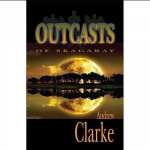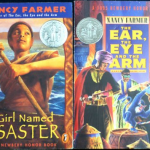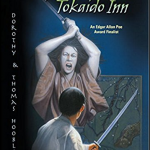
now browsing by day
Outcasts of Skagaray


Title: Outcasts Of Skagaray
Author: Andrew Clarke
Primary Audience/age group: 13+
Genre: Fantasy
# Of pages: 240
Publisher: VMI Publishing
Year of Release: 2006
Part of a Series? No
Rating: 3 (View Scale)
Recommend? Yes!
Author: Andrew Clarke
Primary Audience/age group: 13+
Genre: Fantasy
# Of pages: 240
Publisher: VMI Publishing
Year of Release: 2006
Part of a Series? No
Rating: 3 (View Scale)
Recommend? Yes!
Description: The world of Skagaray is dark and bleak but there is the possibility of beauty and goodness too. The people of Skagaray respect strength, and hardness, and make gods in their own image to please themselves. They reject those they consider weak, or unworthy, and make outcasts of them. But one among them rejects their cruelty, and will not take part in the brutality they call their Proving. This is Australian Andrew Clarkes first novel.
Review: Outcasts of Skagaray started out slow, it took me about 50 pages to get into the book, but once I did, it was a fun, exciting read. This is a story about change. Tarran, the main character had never seen a way of life that was not savage and harsh. But something inside him was sure that people could be different. He musters up the courage to leave Skagaray, where only the strong are honored and the weak are left to die. Once he is an Outcast his fear of the Skagaray ways turns to anger, which eventually yields to love. A foreigner, Ambrand returns to the area and tells Tarran about the One True God, who was killed but got up from the dead. This God does not murder the weak, He teaches that love is stronger than hate. Tarran and Ambrand lead the fight against the evil forces at work in Skagaray. They seek to spread the news that there is a different way to live, a better way, where the citizens are free from the laws of hate, killing, slavery and shame.
I really liked Tarran and rooted for him the entire story. I had a hard time telling many of the characters apart/keeping them straight – I think because they had such different names. The story was about clear good versus evil and how every person must choose to which side they belong.
I really liked Tarran and rooted for him the entire story. I had a hard time telling many of the characters apart/keeping them straight – I think because they had such different names. The story was about clear good versus evil and how every person must choose to which side they belong.
Rating: 3, for violent/confrontational situations
Positive: Tarran was a great character – he knew that the life he was living was wrong, and left that life. He helped others leave their way of life and once he knew the Truth, he shared that with everyone he could.
Spiritual Elements: As you can read in my review, the people of Skagaray must choose between good and evil. Do they continue to worship the Kirkril as they have been taught their whole lives – or the One True God who they just learned about?Violence: I found the story to be quite violent. There arent any gory details of blood and guts – but just many references to their ways as being slayers, hunters, killers. It is the will of the Skagaray gods that the strong shall live by killing. Life is a battle and you are to be warriors. The mark of the warrior is blood, the destruction of enemies, prey taken, the defeat of another. The lives you take enlarge you.Language: NoneSexual Content: None
Other: Some of the evil elders drank wine.
Recommendation: I would recommend this book to boys (and girls) who like this genre, ages 13+. I know my son will enjoy it! I feel like it is too violent for children under 13
A Girl Named Disaster


Title: A Girl Named Disaster
Author: Nancy Farmer
Primary Audience/age group: 14+
Genre: Adventure/Coming of Age story/Multicultural
# Of pages: 293
Publisher: Orchard Books
Year of Release: 1996
Part of a Series? No
Rating: 3 (View Scale)
Recommend: Yes, with reservation
Description: (from book jacket) Her grandmother said, The journey will be the hardest thing youll ever do, but it will be worth it. Just think of finding your father. And so Nhamo, fleeing an impending marriage to a cruel man with three wives, sets out for Zimbabwe, alone on the Musengezi River. She is not yet twelve. Soon, strong currents sweep her canoe to the uncharted heart of Lake Cabora Bassa in Mozambique. As she struggles to escape drowning and starvation, she comes close to the luminous world of the African spirits. Loneliness drives her to join a baboon troop on an island, with near-deadly results. But Nhamo is bold and resourceful and discovers in conversations with her dead mother and the Ancestors how to survive the terrors that seem to rise around her from all sides. Yet the greatest terror is still to come after she again reaches civilization. Nhamos journey of spirit as well as body will keep readers enthralled to the very last page.
Review: Well, it didnt keep me enthralled to the very last page, but I have to admit, I felt compelled to continue reading this book until the end. Ive never been a big fan of the girl facing the dangers of nature alone with animal friends genre (as in Julie of the Wolves or Island of the Blue Dolphins, which this book resembles). Several times I found myself feeling somewhat impatient when the narrative came to a stop so Nhamo could tell a story about the African spirits, and sometimes I wanted to shake her and say, Quit letting yourself starve! Have some common sense and get off that island! However, Nhamo is a sympathetic enough character that I wanted to see how her story ended.
Rating: 3 for more intense sequences of violence
Recommend: Yes, with reservation
Positive: Nhamo is resourceful and self-reliant. She works hard and manages to survive a journey one would think would be impossible for a young girl. The book also is a good example of multicultural literature, describing life in a primitive African village and set against the background of the civil wars in the history of southern Africa.
Spiritual Elements: Spiritual elements are at the heart of this book. It is because of a ngozi (angry, revengeful spirit) who is revealed by a muvuki (what we would call a witch doctor) that she has to leave her home. During her journey, Nhamo converses on a regular basis with the spirits of her dead mother and a dead villager whose boat she has taken to escape the village. She also gets advice from the njuzu, the water spirits, and makes sure she makes appropriate sacrifices to thank them and the Ancestors. One of the most disturbing parts of the book is when she encounters the spirit of a witch, who later possesses her and has to be exorcised by the Vapostori (a sect of Christians that was formed in Africa in 1932). The book also gives Nhamos reactions to Christianity, which may disturb some readers, since she interprets it through the lens of her spirit religion.
Violence: Although the violence isnt glorified, there is quite a bit of it inherent in the story. Its taken for granted that people have the right to beat other people who displease them. Nhamo has to kill animals to provide food for herself, and the grossest scene of violence comes with her first experience of hunting. The most disturbing scenes of violence, though, come when Nhamo is possessed by the witch and kills a dog that is chasing her away from white peoples houses, and then again later when she attacks another dog who reminds her of the first one.
Language: It seems that I remember a few offensive words, but a very few. The most offensive thing I remember is the witchs name (Long Teats).
Sexual Content: The sexual content of the book is centered around menstruation as a sign of womanhood. The story describes the rituals that Nhamos family undertakes when her cousin has her first period and becomes a marriageable young woman. Later, when Nhamo is on her journey, she reaches the same milestone. Its not a major theme in the book, but it is mentioned now and then. At the end of the book, Nhamo finds out her mother was already pregnant when she married Nhamos father.
Other: There is a LOT of information about southern Africa in this book, ranging from the native religion, to the types of plants and animals, to the weather patterns, to the interaction between natives and whites. Although I got annoyed that Nhamo would go into storytelling mode and pause the narrative, her stories were interesting. Given that I knew next to nothing about Africa before reading the book, I think it has value as a teaching tool by managing to work all these elements into a book that reads like a story instead of a textbook. There are also sections at the end of the book that provide a glossary of the African words used in the story and an overview of the spirit religion.
Recommendation: I would suggest this book for more mature teens. I think younger kids would be turned off by the frequent use of African words and embarrassed by the frank way the book talks about menstruation. The focus on the spirit world and its differences to Christianity might be something parents and teens could discuss, as well.
The Ghost in the Tokaido Inn


Title: The Ghost in the Tokaido Inn (The Samurai Mysteries)
Author: Dorothy & Thomas Hoopler
Primary Audience/age group: 12+
Genre: Historical fiction/mystery
# Of pages: 214
Publisher: Puffin Books
Year of Release: 1999
Part of a Series? Yes, the Hooplers have written several books featuring these characters
Rating: 3 (View Scale)
Recommend: YesDescription: (from book cover) Fourteen-year-old Seikei dreams of being one of the legendary warriors, a samurai but samurai are born, not made, and Seikei is a tea merchants son. Then a priceless ruby intended for the shogun the military governor of Japan is stolen by a ghost, and Seikei finds himself having to display all the courage of a samurai. He is the only person to have seen the thief, and now the famous samurai magistrate, Judge Ooka, needs Seikeis help to solve the mystery. Soon the two are hot on the trail of the ruby and an unforgettable adventure.
Author: Dorothy & Thomas Hoopler
Primary Audience/age group: 12+
Genre: Historical fiction/mystery
# Of pages: 214
Publisher: Puffin Books
Year of Release: 1999
Part of a Series? Yes, the Hooplers have written several books featuring these characters
Rating: 3 (View Scale)
Recommend: YesDescription: (from book cover) Fourteen-year-old Seikei dreams of being one of the legendary warriors, a samurai but samurai are born, not made, and Seikei is a tea merchants son. Then a priceless ruby intended for the shogun the military governor of Japan is stolen by a ghost, and Seikei finds himself having to display all the courage of a samurai. He is the only person to have seen the thief, and now the famous samurai magistrate, Judge Ooka, needs Seikeis help to solve the mystery. Soon the two are hot on the trail of the ruby and an unforgettable adventure.
Review: So honorable! So beautifully innocent! This is what the jewel thief says about Seikei, and I think it is an apt description of both Seikei and the book that tells his story. In his efforts to be like the samurai he aspires to be, Seikei tries to be honorable in all he does, even when it wouldnt (I think) be expected of someone so young. In my opinion, that makes Seikei a very likeable character, which is the strength of the book. The mystery itself is not too difficult to unravel, but the reader will enjoy following Seikei along as he figures it out and as he deals with the contradictions between who he is and who he wants to be.
Rating: 3, for violence
Positive: This book does an excellent job in presenting the Edo period of Japanese history, especially the class divisions and cultural achievements. Although there is a lot of history in the book, it is woven into the story in a credible, entertaining way the reader never feels the author is lecturing. On a more personal level, Seikeis sense of honor and his efforts to live up to it are admirable, especially when contrasted with adult characters who are full-fledged samurai and yet are not as honorable as this merchants son.
Spiritual Elements: I was surprised by how much religion played a role in this story. One of the main plotlines centered around a character who is a Christian in the time when it was illegal to be one in Japan. However, that characters behavior seems to be more heavily influenced by the samurai code of honor. There is a lot of interesting cultural information about Japanese religion, including a chapter that deals with an offering to their goddess Amaterasu.
Violence: I was also surprised by the amount of violence in the book, although I suppose I shouldnt have been, since it is about samurai. However, the violence is generally not gory or drawn-out (the climatic scene is a bit more violent than scenes in the rest of the book). I wouldnt have reservations about letting a younger teen read the book. Since Seikei longs to be a samurai, there is quite a bit of glorification of the sword as the samurai weapon. There are a number of characters who either commit ritual suicide or are executed with the sword to uphold a sense of honor.
Language: The book doesnt use any offensive language.
Sexual Content: The book doesnt really have any sexual content. If there is any, it is so subtle I think it would be a stretch to be offended by it.
Other: Some characters drink alcohol. Some readers might possibly be offended by the way Christianity is presented, but I think its important to remember the story is being told from the viewpoint of a Japanese character who wouldnt understand the idea of a suffering servant god.
Rating: 3, for violence
Recommendation: I would definitely recommend this book, especially for boys who, like my son, are fascinated by Japanese culture thanks to some programs in the mainstream media. I would also recommend it to parents who are looking for a cool way to introduce their child to other cultures. It is outstanding historical fiction.
Outriders


Title: Outriders (The Birthright Project, Book 1)
Author: Kathryn Mackel
Primary Audience/age group: 12+
Genre: Fantasy/Science Fiction, YA Christian Fiction
# Of pages: 320
Publisher: Thomas Nelson
Year of Release: 2007
Part of a Series? Yes, 1st in the Birthright Project Series
Rating: 4 (View Scale)
Recommend?: Yes!
This daring team roams the blighted earth. They are Outriders, young warriors who wield swords and wits to protect the birthrighter camps. When rookie birthrighters arrive from the Ark, however, the battle turns into something no one expected. Not only must they battle the merciless warlord Alrod and his horde of gigantic mutants, but a new and more powerful enemy has revealed itself, a darkness that threatens to destroy the world theyve been charged to save.Review: Outriders (The Birthright Project, Book 1) is set in the future after the Earth has been basically destroyed by war. Surviving Christians were led by God to build an underground Ark from which they eventually send their called believers (aka missionaries) on missions – they protect those that need protecting, send specimens back to the ark, and spread the word about the grace of God. I really enjoyed the characters in this book – they were well developed and relatable. They werent perfect, yet God used them to spread His message and protect His people. I know that after my 13 yr. old son reads it he will anxiously urge me to get him the rest in the series.Rating: 4 for mild violence and intense scenes
is set in the future after the Earth has been basically destroyed by war. Surviving Christians were led by God to build an underground Ark from which they eventually send their called believers (aka missionaries) on missions – they protect those that need protecting, send specimens back to the ark, and spread the word about the grace of God. I really enjoyed the characters in this book – they were well developed and relatable. They werent perfect, yet God used them to spread His message and protect His people. I know that after my 13 yr. old son reads it he will anxiously urge me to get him the rest in the series.Rating: 4 for mild violence and intense scenes
Positive: The relationship between the Outriders was very realistic and each character was written in such a manner to illustrate to readers that while we are all different and imperfect – God uses us as we are to change us into who He wants us to be.
Author: Kathryn Mackel
Primary Audience/age group: 12+
Genre: Fantasy/Science Fiction, YA Christian Fiction
# Of pages: 320
Publisher: Thomas Nelson
Year of Release: 2007
Part of a Series? Yes, 1st in the Birthright Project Series
Rating: 4 (View Scale)
Recommend?: Yes!
Description: From the back of the book: Delivered through the polar ice by a whale, their journey is nothing short of miraculous, their mission, nothing short of impossible. Their quest is to reclaim Gods birthright and preserve the original creation that is being mutated out of existence.
This daring team roams the blighted earth. They are Outriders, young warriors who wield swords and wits to protect the birthrighter camps. When rookie birthrighters arrive from the Ark, however, the battle turns into something no one expected. Not only must they battle the merciless warlord Alrod and his horde of gigantic mutants, but a new and more powerful enemy has revealed itself, a darkness that threatens to destroy the world theyve been charged to save.Review: Outriders (The Birthright Project, Book 1)
Positive: The relationship between the Outriders was very realistic and each character was written in such a manner to illustrate to readers that while we are all different and imperfect – God uses us as we are to change us into who He wants us to be.
Spiritual Elements: The whole book is a fight of good against evil, darkness against light, right against wrong. All the while acknowledging the One True God and His Spirit that dwells within believers.
Violence: There are many battles and intense scenes. Nothing gory or graphic – just intense.
Language: None
Sexual Content: The evil warlord Alrod keeps his eyes open for pretty virgin girls that can birth a child for him because his wife is unable to have children. No details on attempts to impregnate girls are given.
Other: There are a couple instances where ale is referred to being consumed, one time someone is referred to as being drunk on ale.
There are many statements on social issues that you may or may not take issue with ex: at one point the Outriders wondered if there had been some point during or after the Endless Wars when mankind could have stopped this pillage, this rape of the environment and one another for selfish gain.
Alrod gathers people from surrounding villages and morphs them into odd/disfigured creatures.
Recommendation: It took me a while to get into this book, but about 1/3 of the way in, I was hooked. The beginning is somewhat confusing as you try to figure out what environment they are living in and the details of their existence. However, once through that you are taken on an adventure that will have you cheering out-loud for the Outriders.